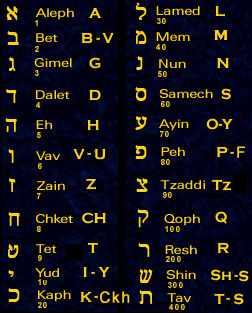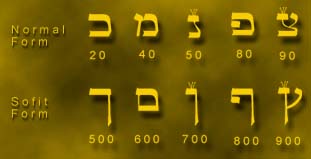
Double Letters, Sofit Letters, & Vowels
Hebrew is an ancient language, that has been kept alive over the millennia by Jewish tradition. It is the language in which the Torah (Old Testament) is written. (Some scholars suggest that Hebrew is a remnant of the Egyptian language, with a Chaldaen letter system pressed into the use of writing the Egyptian words). It was used by the Hebrews for 2000 years, and was lost only when Jerusalem fell to the Romans in the year 70. For almost 1800 years, it was not spoken as a daily tongue, but used primarily as the language of prayer, or mixed with German, Polish and Russian, becoming Yiddish, or Spanish, becoming Ladino. In the last 150 years, pure Hebrew has been revived as a functional means of daily communication, secular and even technical reporting.
Learning Hebrew is not as daunting as it might seem. The first task is to memorize the alef/beis (alphabet), and the sofit letters. Then, since the alefbeis has no vowels, the vowel points have to be learned. Finally, there are some exceptions to the vowel structures that round out the method of reading.
alefbeis

The chart above shows the Hebrew alphabet with the name of the letter, and the approximate equivalent sound in English (and the numerical value) . Double and Sofit letters are explained below.
Double Letters
There are seven of the 22 letters that are called "Double Letters." Originally all seven had two sounds, but now only four of them are used with two sounds. A dot is used to show which of the two sounds a letter gets. The hard sound is indicated with the dot. Each hard sound is a "plosive," pronounced with an explosive puff of sound. The soft sounds are "fricatives," made by friction of breath in a narrow opening.
Tikkuney Zohar says that the hard and soft sounds are related to the "Chayot running and returning" (Ezekiel 1:14). It says, "they run with the hard sound and return with the soft."
|
from Sepher Yetzirah: "This teaches that one cannot focus for any length of time on any of the Sefirot. The mind can concentrate and see them as a "flash of lightning," but only for an instant. Then one must return. One oscillates between "running and returning," peeking for an instant, and then immediately returning to one's normal state." |
Another image of running and returning is in Jacob's dream, in Bereshis (Genesis), at 28:12:
"And he dreamt, and behold! A ladder was set earthward and its top reached heavenward; and behold! angels of the Creator were ascending and descending on it."
Thus, Jacob's Ladder is a metaphor for the Tree of Life, with the Double Letters as one way to conceive of traversing the Tree.
THE DOUBLES
The hard sound of this letter is a B sound. The soft sound is a V sound. This letter is called either beis or bet, because the last letter of "house" or "beis" is another double letter (see below).
The use of Gimel as a double letter is archaic. The soft gimel is a J sound, like "corsage," which was dropped from usage after the destruction of the Temple, and by the 10th century used only by the Mazya community in Tiberias. On the whole, gimel is a solid G sound, like "gift," though in liturgy it is sometimes shown dotted. Gimel means "camel."
The use of Dalet as a double letter is also archaic. The soft dalet is a DTH sound, like "breadth," and is rarely used. On the whole, dalet is a solid D sound, like "window," though in liturgy it is sometimes shown dotted. Dalet means "Window."
The hard Kaf sound is a K, like "King." The soft Kaf sound is difficult for many. It is guttural, and deep throated, like "ach!" It is like "hocking up a loogie," or the sound one makes trying to get a sunflower seed husk or similar obstruction out of your throat. It is not a "polite" sound to western ears, and testifies to the ancient and even barbaric origins of the language. Kaf means "cupped hand."
The hard Peh sound is a P, like "Peek." The soft Peh sound is an F sound, like "fig." It is interesting to compare the two sounds while remembering the meaning of the word Peh, mouth.
The use of Resh as a double letter is also archaic. Possibly the hard resh was like the Spanish rolled R, and the soft was a throaty French R. Today it is a simple R sound, like "Rock." Resh (or Rosh) means "Head."
The hard Tav sound is a T, like "Title." The soft Tav sound is an S sound, like "moss." The alternate soundings are used sporadically, more in the Ashkenaz tradition. In general, Tav is used as a hard sound, whether shown dotted or not. Tav means "sign," or "mark."
Sophit Letters
Five letters take a different form when they are at the end of a word. Sof, as in Ayn Sof Aur (no-end-light) means "end," so the letters that change form are called "sophit." ("so-FEET")

Vowels
The Hebrew system of vowels seems very foreign to westerners. It went through many changes over the millenia, and the system used today was settled on in about year 800. Instead of certain letters always performing the function of vowels, Hebrew uses a system of dots and lines to show how a letter or syllable is pronounced. Certain letters, though not considered vowels, have no sound of their own, and only help "support" a vowel.
Vowel points can be applied to any letter in a word.
Here are the vowels in use.
![]()
patach
The patach is an "ah" sound like a in "far." This letter would be sounded "vah."
![]()
kamatz
The kamatz is also an "ah" sound like a in "far." Askenazi pronounciation makes this an "aw" sound , like the O in "gone." This would be "vah" or "vaw."
![]()
segol
The segol is an "eh" sound. This would be like the VE in "vet."
![]()
tzere
The tsere is a long A, as in "hay." This would be "vay."
![]()
hirik
The hirik is an "EEE" sound like E in "Beet." This letter would be sounded "vee."
![]()
hirik gadol
The "big hirik" only occurs at the end of words, and is a combination of a patach and a letter yud. It gives the "ai" sound, like "fly." This word is "ckhai," which means "life."
![]()
cholam
The cholam is an "oh" sound like O in "Go." This letter would be sounded "vo." European and Yemenite inflections give this an occasional "oi" sound.
![]()
shuruk
The shuruk is an "ooo" sound like O in "Boot." This letter would be sounded "oooo." (The Vav is a letter that sometimes has only a vowel sound. Depending on its placement in a word, this could also be a "voo" sound).
![]()
qubutz
The qubutz is also an "ooo" sound like O in "Boot." This letter would be sounded "voo." (Don't confuse this with "kibbutz," which is an Israeli agricultural commune).
![]()
schva
The schva is an "uh" sound like U in "Duh." This letter would be sounded "vuh," if at the beginning of a word. When it occurs in the middle of the word, the schwa changes into a "glottal stop," signaling the end of a syllable. Here's an example:
![]()
This word is "v'ahavta." Read from right to left, the first syllable is "Vuh." The next syllable is "Ah." The Third syllable is "Hav," because with the schwa vowel mid-word, the V of the beis is the end of the syllable, ending the word with "Tah." (It means "and you will love.")